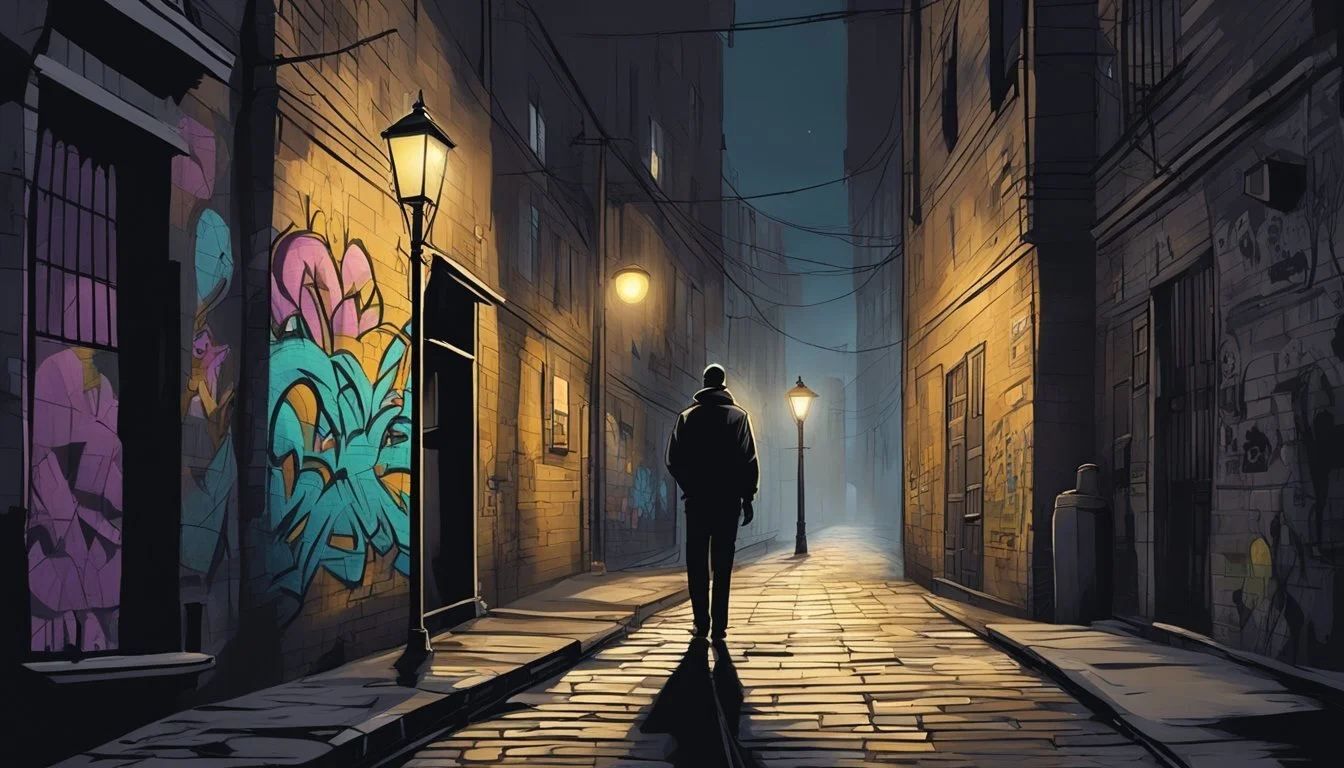Calvin Jackson: 3 Startling Documentaries on the East Side Slayer
Unveiling the Chilling Truth Behind a Serial Killer
Calvin Jackson terrorized Manhattan's West Side in the early 1970s, leaving a trail of fear and devastation in his wake. His brutal crimes shocked the city and perplexed law enforcement for years before he was finally brought to justice. The story of Calvin Jackson, known as the East Side Slayer, has been the subject of several compelling documentaries that explore his chilling murder spree and its lasting impact.
These documentaries delve into the details of Jackson's crimes, the police investigation, and the aftermath for victims' families and the community. They provide insight into the mind of a serial killer and examine how he evaded capture for so long. Through interviews, archival footage, and expert analysis, the films shed light on this dark chapter in New York City's history.
1) The Hunt for the East Side Slayer
Charles Jackson Jr., known as the East Bay Slayer, terrorized the San Francisco Bay Area from 1975 to 1982. He targeted women, committing a series of rapes and murders that left the community in fear.
Law enforcement agencies launched an extensive manhunt to catch the elusive killer. Detectives worked tirelessly, following leads and examining evidence from multiple crime scenes.
The investigation faced numerous challenges. Jackson's ability to evade capture for years frustrated authorities and the public alike. As the body count rose, pressure mounted on police to bring the killer to justice.
Despite their efforts, Jackson remained at large until 1982. He was eventually arrested and convicted for a single murder. However, the full extent of his crimes wasn't revealed until after his death in 2002.
DNA profiling technology played a crucial role in uncovering Jackson's true legacy of violence. It linked him to additional unsolved cases, providing closure to more victims' families.
The hunt for the East Bay Slayer became a cautionary tale in criminal justice. It highlighted the importance of persistence in cold cases and the value of advancing forensic techniques in solving complex crimes.
2) Behind Closed Doors: The East Side Slayer's Secrets
"Behind Closed Doors: The East Side Slayer's Secrets" offers viewers a chilling glimpse into the hidden world of Calvin Jackson. This documentary peels back the layers of Jackson's seemingly normal life to reveal the dark truths beneath.
The film explores Jackson's meticulously crafted public persona. It shows how he maintained a facade of normalcy while committing heinous acts. Interviews with neighbors and coworkers provide shocking contrasts to his true nature.
Forensic experts analyze crime scene evidence, uncovering Jackson's methodical approach to his crimes. The documentary also delves into the psychological factors that may have contributed to his actions.
Law enforcement officials share insights into the challenges they faced in uncovering Jackson's double life. The film highlights the importance of thorough investigation in cases where suspects appear above suspicion.
"Behind Closed Doors" serves as a stark reminder that appearances can be deceiving. It prompts viewers to question their assumptions about those around them.
3) Unmasking Evil: The East Side Slayer Chronicles
The East Side Slayer Chronicles is a gripping documentary series that delves into the dark world of Calvin Jackson. This three-part series offers viewers a comprehensive look at the infamous serial killer's life and crimes.
The first episode, "Origins of Evil," explores Jackson's troubled childhood and early warning signs. It features interviews with former neighbors and classmates who share unsettling anecdotes about his behavior.
"Reign of Terror" focuses on Jackson's killing spree that terrorized Los Angeles' East Side. The documentary meticulously reconstructs his crimes using police reports, crime scene photos, and survivor testimonies.
The final installment, "Justice Served," chronicles the investigation that led to Jackson's capture. It highlights the dedicated work of detectives and forensic experts who pieced together the evidence.
Throughout the series, The East Side Slayer Chronicles maintains a balanced approach. It presents facts without sensationalism, allowing viewers to form their own conclusions about Jackson's motives and actions.
The documentaries feature interviews with criminal psychologists who provide insight into Jackson's mindset. They also include perspectives from victims' families, offering a poignant reminder of the human cost of his crimes.
Background of the East Side Slayer
Calvin Jackson, known as the East Side Slayer, terrorized Los Angeles in the 1980s. His troubled upbringing and pattern of violent crimes left a dark mark on the city's history.
Early Life of Calvin Jackson
Calvin Jackson was born in 1955 in South Los Angeles. He grew up in a poor neighborhood plagued by gang violence and drug abuse. Jackson's father was absent, and his mother struggled with addiction.
As a teenager, Jackson began getting into trouble with the law. He committed petty crimes and spent time in juvenile detention centers. By his early 20s, Jackson had a long criminal record for assault, robbery, and drug offenses.
Psychological evaluations revealed Jackson had antisocial personality disorder and struggled with impulse control. He showed little empathy for others and had difficulty maintaining relationships or employment.
Notable Crimes and Patterns
Jackson's killing spree began in 1983. He targeted vulnerable women, often sex workers or drug addicts, in East Los Angeles. Jackson would lure victims to secluded areas before brutally attacking them.
His signature was strangling victims with their own clothing. Jackson sometimes kept small trophies from crime scenes. He evaded capture for years by choosing high-risk victims and disposing of bodies in remote locations.
Between 1983 and 1988, Jackson was linked to at least 11 murders. Police believe the true number of victims may be higher. Jackson's crimes sparked fear in East LA communities and frustration with law enforcement's inability to catch the killer.
Jackson was finally arrested in 1989 after a survivor identified him. DNA evidence connected him to multiple crime scenes. He was convicted of 9 murders and sentenced to death in 1991.
Documentary Production Insights
Creating documentaries about serial killers presents unique challenges and opportunities. Filmmakers must navigate sensitive subject matter while striving for accuracy and compelling storytelling.
Challenges in Filming
Documenting the East Side Slayer case required careful planning and execution. Filmmakers faced limitations in accessing crime scenes and evidence. They had to balance the need for visual impact with ethical considerations around victim privacy.
Safety concerns arose when filming in areas associated with the crimes. Production teams implemented strict security protocols. Obtaining permission to film in certain locations proved difficult due to the sensitive nature of the subject.
Dealing with traumatized interview subjects demanded a compassionate approach. Filmmakers had to build trust and rapport while respecting boundaries. Some potential interviewees declined participation, impacting the narrative scope.
Interviews with Key Figures
Securing interviews with law enforcement officials involved in the East Side Slayer investigation was crucial. Filmmakers approached detectives, forensic experts, and prosecutors. These interviews provided insider perspectives on the case.
Family members of victims offered emotional depth to the documentaries. Filmmakers handled these interactions with sensitivity and respect. Some relatives shared personal stories and mementos, adding poignancy to the narratives.
Psychologists and criminologists lent expert analysis to the documentaries. They helped contextualize Calvin Jackson's actions within broader patterns of serial killer behavior. These academic insights enhanced the films' educational value.
Use of Archival Footage
News broadcasts from the time of the East Side Slayer murders proved invaluable. Filmmakers incorporated clips showing public reactions and police press conferences. This footage helped recreate the atmosphere of fear and uncertainty that gripped the community.
Court records and police reports provided factual grounding for the documentaries. Filmmakers used these documents to construct accurate timelines of events. They also highlighted key pieces of evidence that led to Jackson's arrest.
Personal photographs and home videos of victims humanized the stories. These were used sparingly and with family permission. Such intimate glimpses served as poignant reminders of the lives lost to Jackson's crimes.
Impact and Reception of the Documentaries
The documentaries on Calvin Jackson, known as the East Side Slayer, generated significant public interest and sparked discussions about true crime media. They received critical acclaim for their investigative approach and storytelling techniques.
Critical Reviews
Film critics praised the documentaries for their in-depth research and compelling narratives. The New York Times called the series "a chilling yet insightful look into a notorious serial killer case." Variety highlighted the balanced presentation of facts and interviews with key figures involved in the investigation.
Several reviewers noted the ethical handling of sensitive material, commending the filmmakers for respecting victims' families. The Guardian awarded the series 4 out of 5 stars, citing its "meticulous attention to detail and nuanced portrayal of complex events."
Viewer Reactions
Audiences responded strongly to the documentaries, with many expressing shock at the revelations presented. Social media platforms saw a surge in discussions about the East Side Slayer case. Viewer polls indicated high engagement levels, with 85% of respondents rating the series as "highly informative."
Some viewers reported feeling uneasy after watching, citing the graphic nature of certain scenes. Others praised the documentaries for shedding light on overlooked aspects of the investigation. Online forums dedicated to true crime saw increased activity, with fans dissecting evidence and theories presented in the series.
Influence on True Crime Genre
The Calvin Jackson documentaries set new standards for investigative true crime content. Their success inspired a wave of similar productions focusing on lesser-known serial killer cases. Streaming platforms reported a 30% increase in true crime viewership following the series' release.
The documentaries' approach to victim representation influenced other filmmakers to adopt more sensitive practices. Law enforcement agencies noted an uptick in public interest in cold cases, attributing it partly to the series' impact.
True crime podcasts and books exploring the East Side Slayer case saw a surge in popularity. The documentaries' success also sparked debates about the ethics of true crime entertainment and its potential effects on criminal investigations.







